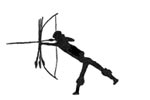Malende Elephanten, usw ...
52 Beiträge
• Seite 1 von 3 • 1, 2, 3
Malende Elephanten, usw ...
In Thailand wurden Elephanten jahrelang als Lasttiere für den Holzeinschlag gebraucht.
Inzwischen ist der Holzeinschlag in Thailand aus Umweltgründen reglementiert. So mancher Holzfäller wurde arbeitslos, um mit ihm sein Elephant.
Findige Thailander haben ihren Elephanten darauf dressiert, Bilder für Touristen zu malen.
8 Minuten Youtube:
http://www.youtube.com/watch?gl=DE&hl=de&v=CXOUs2nylAo
Inzwischen ist der Holzeinschlag in Thailand aus Umweltgründen reglementiert. So mancher Holzfäller wurde arbeitslos, um mit ihm sein Elephant.
Findige Thailander haben ihren Elephanten darauf dressiert, Bilder für Touristen zu malen.
8 Minuten Youtube:
http://www.youtube.com/watch?gl=DE&hl=de&v=CXOUs2nylAo
Du hast keine ausreichende Berechtigung, um die Dateianhänge dieses Beitrags anzusehen.
-

smalonius - Beiträge: 623
- Registriert: Sa 11. Apr 2009, 18:36
Re: Malende Elephanten, usw ...
Mich würde mal interessieren, ob der Elephant das Motiv selber entwickelt, oder ob er nur nachmacht, was er gelernt hat. (Tippe auf letzteres.)
-

Jakob - Beiträge: 419
- Registriert: Sa 29. Sep 2007, 15:56
- Wohnort: Augsburg/Nürnberg
Re: Malende Elephanten, usw ...
Elefanten haben ein gutes Gedächtnis für Orte und Wege und sie können sich individuelle Menschen mit genügend Eigenschaften einprägen um diese noch Jahre später zu mögen oder nicht zu mögen.
Es würde mich überaschen, wenn sich herausstellte, dass Elefanten kein Selbstbild hätten, das über die Selbstidentifikation als Teil der Herde hinausgeht.
Dass sie aber in der Lage sind, dieses Selbstbild auch zu stilisieren und abzubilden bzw. sich selbst in solchen stilisierten Bildern zu erkennen, halte ich für fragwürdig.
Also ja, dieses Zeichnen ist ganz bestimmt antrainiert.
Es würde mich überaschen, wenn sich herausstellte, dass Elefanten kein Selbstbild hätten, das über die Selbstidentifikation als Teil der Herde hinausgeht.
Dass sie aber in der Lage sind, dieses Selbstbild auch zu stilisieren und abzubilden bzw. sich selbst in solchen stilisierten Bildern zu erkennen, halte ich für fragwürdig.
Also ja, dieses Zeichnen ist ganz bestimmt antrainiert.
-

Twilight - Beiträge: 663
- Registriert: Do 20. Dez 2007, 15:40
- Wohnort: Verstecke mich... unter deinem Bett!
Re: Malende Elephanten, usw ...
Das glaub ich nicht.
Man sieht den Trainer nicht, was der tut. Elefanten sind sehr feinfühlig und es ist durchaus denkbar, dass er irgendwie geführt wird. Nach den operationsnarbenfreien Organentwendungen der asiatischen Wunderheiler würde mich so ein Betrug zur Touristenabzocke auch nicht wundern.
Ich meine das ist einfach eine gutgemachte Zirkusnummer!
LG stine
Man sieht den Trainer nicht, was der tut. Elefanten sind sehr feinfühlig und es ist durchaus denkbar, dass er irgendwie geführt wird. Nach den operationsnarbenfreien Organentwendungen der asiatischen Wunderheiler würde mich so ein Betrug zur Touristenabzocke auch nicht wundern.
Ich meine das ist einfach eine gutgemachte Zirkusnummer!
LG stine
-

stine - Beiträge: 8022
- Registriert: Do 27. Sep 2007, 08:47
Re: Malende Elephanten, usw ...
Alle Achtung - die Bilder sind besser als alles was ich machen könnte (ich armes musenungeküsstes Patscherl) - wobei das schon schwer nach Hoax riecht 
-

russellsteapot - Beiträge: 217
- Registriert: Di 17. Feb 2009, 00:56
- Wohnort: Innsbruck
Re: Malende Elephanten, usw ...
Mir geht's da wie der Teekanne, meine Malkünste sind nicht besonders groß.
Da wär's egal, ob ich aus dem Gedächtnis malte, oder mir mein Trainer nur durch Druck hinter mein Ohr vorgeben würde, wie der Pinsel zu führen ist.
Ein Hoax scheint es nicht zu sein, jedenfalls wenn man Snopes glaubt.
http://www.snopes.com/photos/animals/el ... inting.asp
Über eins sind wir uns bestimmt einig: von selbst sind die Elephanten sicher nicht auf's Malen gekommen. Ohne Anleitung würden sie wohl auch nur 'rumklecksen, wie man es von Menschenaffen kennt.
Eine Frage bleibt für mich: wieviel von dem was sie malen, verstehen oder erkennen die Elephanten? Man weiß, daß sich manche Exemplare im Spiegel wiedererkennen. Ich bin ein bin ein bißchen skeptisch, will's aber auch nicht ausschließen, denn ich denke, man traut Tieren immer noch zu wenig zu.
(...wird fortgesetzt.)
Da wär's egal, ob ich aus dem Gedächtnis malte, oder mir mein Trainer nur durch Druck hinter mein Ohr vorgeben würde, wie der Pinsel zu führen ist.
Ein Hoax scheint es nicht zu sein, jedenfalls wenn man Snopes glaubt.
http://www.snopes.com/photos/animals/el ... inting.asp
Über eins sind wir uns bestimmt einig: von selbst sind die Elephanten sicher nicht auf's Malen gekommen. Ohne Anleitung würden sie wohl auch nur 'rumklecksen, wie man es von Menschenaffen kennt.
Eine Frage bleibt für mich: wieviel von dem was sie malen, verstehen oder erkennen die Elephanten? Man weiß, daß sich manche Exemplare im Spiegel wiedererkennen. Ich bin ein bin ein bißchen skeptisch, will's aber auch nicht ausschließen, denn ich denke, man traut Tieren immer noch zu wenig zu.
(...wird fortgesetzt.)
-

smalonius - Beiträge: 623
- Registriert: Sa 11. Apr 2009, 18:36
Re: Malende Elephanten, usw ...
Im Threadtitel heißt es "usw." Ein paar mehr Beispiele habe ich noch.
Von Menschenaffen weiß man inzwischen, daß sie eine Kultur des Werkzeuggebrauchs besitzen. Das soll heißen, ihr Gebrauch von Werkzeugen ist erlernt und kein Instinkt.
Einige Menschenaffengruppen benutzen zum Beispiel Stöcke, um nach Insekten zu angeln, andere benutzen Steine, um Nüsse zu knacken. Welches Werkzeug und welche Technik verwendet wird, hängt davon ab, in welcher Sippe eine Affe aufgewachsen ist. --> Kultur.
Ausstellungsstück 2
Man hat japanische Studenten gegen junge Schimpansen antreten lassen.
Eine Zahlenfolge wurde kurz auf einem Bildschirm angezeigt.
6-9-7-1-4-3-2-8-5-0
Dann wurden die Zahlen verdeckt
x-x-x-x-x-x-x-x-x-x
Es galt die Ziffern in aufsteigender Reihenfolge richtig hintereinander am berührungsempfindlichen Bildschirm nachzuvollziehen.
Die Schimpansen waren den Studenten überlegen.
Von Menschenaffen weiß man inzwischen, daß sie eine Kultur des Werkzeuggebrauchs besitzen. Das soll heißen, ihr Gebrauch von Werkzeugen ist erlernt und kein Instinkt.
Einige Menschenaffengruppen benutzen zum Beispiel Stöcke, um nach Insekten zu angeln, andere benutzen Steine, um Nüsse zu knacken. Welches Werkzeug und welche Technik verwendet wird, hängt davon ab, in welcher Sippe eine Affe aufgewachsen ist. --> Kultur.
Ausstellungsstück 2
Man hat japanische Studenten gegen junge Schimpansen antreten lassen.
Eine Zahlenfolge wurde kurz auf einem Bildschirm angezeigt.
6-9-7-1-4-3-2-8-5-0
Dann wurden die Zahlen verdeckt
x-x-x-x-x-x-x-x-x-x
Es galt die Ziffern in aufsteigender Reihenfolge richtig hintereinander am berührungsempfindlichen Bildschirm nachzuvollziehen.
Die Schimpansen waren den Studenten überlegen.
-

smalonius - Beiträge: 623
- Registriert: Sa 11. Apr 2009, 18:36
Re: Malende Elephanten, usw ...
Sieht jedenfalls so aus, als würde der Elefant das wirklich zeichnen - und mit einer unglaublichen Abstraktion. Man könnte natürlich einem Elefanten ein ferngesteuertes biegbares Gerät in den Rüssel schieben, mit dem man ihn dann fernsteuert: Das müsste man doch aber nachprüfen können, ob da irgendetwas gefaket wurde.
- HF*******
- Beiträge: 2651
- Registriert: Do 19. Okt 2006, 11:59
Re: Malende Elephanten, usw ...
HFRudolph hat geschrieben:Sieht jedenfalls so aus, als würde der Elefant das wirklich zeichnen - und mit einer unglaublichen Abstraktion. Man könnte natürlich einem Elefanten ein ferngesteuertes biegbares Gerät in den Rüssel schieben, mit dem man ihn dann fernsteuert: Das müsste man doch aber nachprüfen können, ob da irgendetwas gefaket wurde.
Ich denke, daß der Elephant etwas malt, was er irgendwann beigabracht bekommen hat. Sind ja gelehrige Viecherl. Aber ich glaube nicht, daß er das Gemälde als Artgenossen identifizieren kann. Wahrscheinlich geht's ihm wie mir, wenn ich in einer Ausstellung von abstrakter Kunst stehe. Ich erkenne nix.
smalonius hat geschrieben:Im Threadtitel heißt es "usw." Ein paar mehr Beispiele habe ich noch.
Von Menschenaffen weiß man inzwischen, daß sie eine Kultur des Werkzeuggebrauchs besitzen. Das soll heißen, ihr Gebrauch von Werkzeugen ist erlernt und kein Instinkt.
Einige Menschenaffengruppen benutzen zum Beispiel Stöcke, um nach Insekten zu angeln, andere benutzen Steine, um Nüsse zu knacken. Welches Werkzeug und welche Technik verwendet wird, hängt davon ab, in welcher Sippe eine Affe aufgewachsen ist. --> Kultur.
Killerwale benutzen je nach Rudel verschiedene Jagdtaktiken und -techniken, die die Jüngeren von den Älteren lernen. Trennt man ein Jungtier von der Gruppe, wird es die fraglichen Techniken nicht entwickeln. Es handelt sich also um eine bzw. viele Kulturen der Jagdtaktik.
-

Jakob - Beiträge: 419
- Registriert: Sa 29. Sep 2007, 15:56
- Wohnort: Augsburg/Nürnberg
Re: Malende Elephanten, usw ...
Ob ihr's glaubt oder nicht, aber auch folgendes ist kein Fake:
http://www.snopes.com/photos/animals/dolphinrings.asp
http://www.snopes.com/photos/animals/dolphinrings.asp
-

Peter Janotta - Beiträge: 1492
- Registriert: Mo 26. Mär 2007, 10:53
- Wohnort: Würzburg
Re: Malende Elephanten, usw ...
Irgendwo muß ich noch einen Link zu einem Banausen-Test haben. Mal 'rauskramen, dann werden wir sehen, wie das Forum sich so schlägt.Jakob hat geschrieben:Wahrscheinlich geht's ihm wie mir, wenn ich in einer Ausstellung von abstrakter Kunst stehe. Ich erkenne nix.
Linky?Jakob hat geschrieben:Killerwale benutzen je nach Rudel verschiedene Jagdtaktiken und -techniken, die die Jüngeren von den Älteren lernen. Trennt man ein Jungtier von der Gruppe, wird es die fraglichen Techniken nicht entwickeln. Es handelt sich also um eine bzw. viele Kulturen der Jagdtaktik.
Das ist ein interessanter Punkt, daran hatte ich gar nicht gedacht. Soweit ich weiß, ist das eins der Probleme, wenn man Tiere wieder auswildern will: ihnen fehlen angelernte Verhaltensweisen.
Muß man das jetzt auch als "Kultur" sehen?
Der Werkzeuggebrauch der Schimpansen geht noch einen Schritt weiter. Auf Jane Godalls hompage heißt es:
David had been using the stem as a tool to "fish" for insects!
Soon after this discovery, Jane observed David and other chimps actually picking leafy twigs then stripping the leaves so that the twig was a suitable tool. This was modification of an object to make a tool — the crude beginning of tool making.
Until that time scientists thought that humans, and only humans, used and made tools. Our species was defined as "Man the Tool Maker." That ability was thought to separate us from other animals more than any other characteristic.
When Louis Leakey received an excited telegram from Jane describing her discoveries he made his now famous response: "Now we must redefine tool, redefine Man, or accept chimpanzees as humans."
http://www.janegoodall.org/chimp_centra ... e/tool.asp
Falls jemandem langweilig ist, hier spricht Jane Godall 15 Minuten lang über ihre Erfahrungen mit Schimpansen. Dann spricht sie 15 Minuten darüber, was den Menschen vom Tiere unterscheidet.
http://www.ted.com/talks/jane_goodall_o ... _apes.html
Peter Janotta hat geschrieben:Ob ihr's glaubt oder nicht, aber auch folgendes ist kein Fake:
http://www.snopes.com/photos/animals/dolphinrings.asp
Etwas aus Spaß an der Freude zu tun, müßte man vielleicht auch noch in die Definition "menschlicher" Charakteristiken einfügen.
Jedenfalls scheinen die Delphine das aus harmlosem Vergnügen zu tun. Was aber soll man von folgender Meldung halten?
Steine werfen wie die Raben
Aus "purer Lust am Vandalismus", schreibt die Bundespolizei, haben sich die am Vordach des Ostbahnhofs ansässigen Raben Steine zurechtgerollt und diese gezielt auf die Autodächer der darunter stehenden Taxis geschubst.
Ein erboster Fahrer, der am Donnerstag zur Anzeigenerstattung auf dem Revier erschien, glaubte noch an einen Täter aus der Art Homo sapiens. Die Ermittlungen der Polizei allerdings führten eindeutig zur Rabenbande. Dingfest konnte man die Vögel nicht machen.
http://www.sueddeutsche.de/u5k38k/29104 ... Raben.html
[Link leider nicht mehr aktuell, führt ins Archiv]
Ob jemand der mitlesenden Münchner das bestätigen kann?
-

smalonius - Beiträge: 623
- Registriert: Sa 11. Apr 2009, 18:36
Re: Malende Elephanten, usw ...
smalonius hat geschrieben:Linky?
Sorry, entfällt. Habe ich mal in der Glotze gesehen. Schon 'ne Weile her.
("Fernsehen macht die Klugen klüger und die Dummen dümmer." hat mein Deutschlehrer immer gesagt.)
-

Jakob - Beiträge: 419
- Registriert: Sa 29. Sep 2007, 15:56
- Wohnort: Augsburg/Nürnberg
Re: Malende Elephanten, usw ...
Diese Meldung geht gerade durch die einschlägigen Medien:
Krähen benutzen ein Werkzeug, um an ein besseres Werkzeug zu kommen, um wiederum an ein besseres Werkzeug zu kommen, um schließlich an Futter zu kommen.
Ein Video gibt es hier zu sehen:
http://www.newscientist.com/article/dn1 ... nline-news
Der Original-Artikel:
Krähen benutzen ein Werkzeug, um an ein besseres Werkzeug zu kommen, um wiederum an ein besseres Werkzeug zu kommen, um schließlich an Futter zu kommen.
Ein Video gibt es hier zu sehen:
http://www.newscientist.com/article/dn1 ... nline-news
Der Original-Artikel:
Cognitive Processes Associated with Sequential Tool Use in New Caledonian Crows
Using tools to act on non-food objects—for example, to make other tools—is considered to be a hallmark of human intelligence, and may have been a crucial step in our evolution. One form of this behaviour, ‘sequential tool use’, has been observed in a number of non-human primates and even in one bird, the New Caledonian crow ...
Here, we present experiments that not only demonstrate new tool-using capabilities in New Caledonian crows, but allow examination of the extent to which crows understand the physical interactions involved.
In two experiments, we tested seven captive New Caledonian crows in six tasks requiring the use of up to three different tools in a sequence to retrieve food. Our study incorporated several novel features:
(i) we tested crows on a three-tool problem (subjects were required to use a tool to retrieve a second tool, then use the second tool to retrieve a third one, and finally use the third one to reach for food);
(ii) we presented tasks of different complexity in random rather than progressive order;
(iii) we included a number of control conditions to test whether tool retrieval was goal-directed; and
(iv) we manipulated the subjects' pre-testing experience.
Five subjects successfully used tools in a sequence (four from their first trial), and four subjects repeatedly solved the three-tool condition. Sequential tool use did not require, but was enhanced by, pre-training on each element in the sequence (‘chaining’), an explanation that could not be ruled out in earlier studies.
By analyzing tool choice, tool swapping and improvement over time, we show that successful subjects did not use a random probing strategy. However, we find no firm evidence to support previous claims that sequential tool use demonstrates analogical reasoning or human-like planning.
http://www.plosone.org/article/info%3Ad ... ne.0006471
-

smalonius - Beiträge: 623
- Registriert: Sa 11. Apr 2009, 18:36
Re: Malende Elephanten, usw ...
Peter Janotta hat geschrieben:Ob ihr's glaubt oder nicht, aber auch folgendes ist kein Fake: http://www.snopes.com/photos/animals/dolphinrings.asp
Der Delphin scheint so etwas wie "Spaß am Gestalten" zu haben, oder kann man es anders erklären?
-

ujmp - Beiträge: 3108
- Registriert: So 5. Apr 2009, 19:27
Re: Malende Elephanten, usw ...
Hier noch was über die Fähigkeit zum Planen, die nicht nur menschliche Tiere draufhaben...
http://www.spiegel.de/wissenschaft/natur/0,1518,416982,00.html
http://science.orf.at/science/news/154863
http://www.spiegel.de/wissenschaft/natur/0,1518,416982,00.html
http://science.orf.at/science/news/154863
-

ujmp - Beiträge: 3108
- Registriert: So 5. Apr 2009, 19:27
Re: Malende Elephanten, usw ...
@smalonius: Das mit der Krähe kannte ich schon - der wesentliche Punkt kommt eigentlich am Schluss: Die Krähe hat das kombiniert, sie konnte das, ohne darauf trainiert worden zu sein… Elstern sind wohl neben Schimpansen bislang so ziemlich die einzigen Tiere, bei denen man nachweisen konnte, dass sie sich selbst im Spiegel erkennen: Wobei es mich nicht wundern würde, wenn das noch bei viel mehr Tieren möglich wäre (was ist mit Delphinen und Tintenfischen?)
Die Ringe des Delphins sind wirklich unglaublich, vielen Dank für den Link. Das ist wie Ringe zu rauchen, nur dass es eben besser aussieht.
Die Ringe des Delphins sind wirklich unglaublich, vielen Dank für den Link. Das ist wie Ringe zu rauchen, nur dass es eben besser aussieht.
- HF*******
- Beiträge: 2651
- Registriert: Do 19. Okt 2006, 11:59
Re: Malende Elephanten, usw ...
In der heutigen Ausgabe der SZ auf der Wissen-Seite steht ein Artikel über Krähen, die in einem Experiment einen Leckerbissen aus einem mit Wasser gefüllten Glas bekommen haben, indem sie durch Einwerfen von Steinen geeigneter Größe den Wasserstand soweit hoben, dass sie mit dem Schnabel drankamen. Bemerkenswert ist, dass wohl keine einzige Krähe vergeblich versuchte, die Belohnung herauszuholen, solange der Wasserstand nicht genau ausreichend war.
-

Nanna - Mitglied des Forenteams

- Beiträge: 3338
- Registriert: Mi 8. Jul 2009, 19:06
Re: Malende Elephanten, usw ...
Ausstellungsstück 3
-

smalonius - Beiträge: 623
- Registriert: Sa 11. Apr 2009, 18:36
Re: Malende Elephanten, usw ...
Bei der Maske, die im zweiten Video getragen wird, mußte ich an Hans, das kluge Pferd, denken.
Der Kluge Hans war ein Pferd, das zählen und addieren konnte. Wenn man es etwas fragte, dann gab es die Antwort als Folge von Hufscharren.
Natürlich konnte das Pferd nicht wirklich zählen oder addieren. Stattdessen hatte es gelernt, auf die Körpersprache der Zuschauer zu achten und im richtigen Moment mit dem Scharren aufzuhören. Das finde ich fast noch bemerkenswerter als 2 + 3 addieren zu können. Ob erwachsene Menschen auch so leicht Körpersprache lesen können?
http://de.wikipedia.org/wiki/Kluger_Hans
Noch was zum obigen Papagei-Video. Da erkennt Alex also Wolle als Wolle und grüne Würfel als grüne Würfel. Viel verblüffender ist aber daß er irgendwann sagt: "Go back". Wie bitte? Ist das jetzt eine Willensäußerung?
(Nebenbei. Da hat Alex die Arschkarte gezogen, wenn er als Papageienvogel sagen muß "Go back", weil man ihm die Flügel gestutzt hat, so daß er nicht mehr davonfliegen kann.)
Der Kluge Hans war ein Pferd, das zählen und addieren konnte. Wenn man es etwas fragte, dann gab es die Antwort als Folge von Hufscharren.
Natürlich konnte das Pferd nicht wirklich zählen oder addieren. Stattdessen hatte es gelernt, auf die Körpersprache der Zuschauer zu achten und im richtigen Moment mit dem Scharren aufzuhören. Das finde ich fast noch bemerkenswerter als 2 + 3 addieren zu können. Ob erwachsene Menschen auch so leicht Körpersprache lesen können?
http://de.wikipedia.org/wiki/Kluger_Hans
Noch was zum obigen Papagei-Video. Da erkennt Alex also Wolle als Wolle und grüne Würfel als grüne Würfel. Viel verblüffender ist aber daß er irgendwann sagt: "Go back". Wie bitte? Ist das jetzt eine Willensäußerung?
(Nebenbei. Da hat Alex die Arschkarte gezogen, wenn er als Papageienvogel sagen muß "Go back", weil man ihm die Flügel gestutzt hat, so daß er nicht mehr davonfliegen kann.)
-

smalonius - Beiträge: 623
- Registriert: Sa 11. Apr 2009, 18:36
52 Beiträge
• Seite 1 von 3 • 1, 2, 3
Zurück zu Das Leben, das Universum und der ganze Rest
Wer ist online?
Mitglieder in diesem Forum: 0 Mitglieder und 17 Gäste
